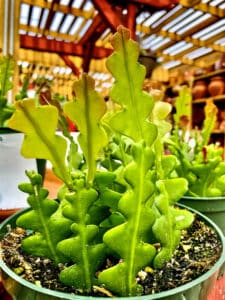Crafting a desert rose Bonsai tree takes time and care, but this particular plant is ideal for both beginners and experts alike. Native to Africa, desert rose Bonsai trees need plenty of sunlight and warm weather conditions in order to thrive. But what should you know about the general care and well-being of this plant and how can you best prune and shape it according to its growth?
Whether you’re brand new to Bonsai tree keeping or want to add a desert rose Bonsai tree to your collection, here’s everything you need to know about this beautiful miniature tree! From its flowers to its roots, desert rose Bonsai trees are worth taking on. Let’s talk about them in detail now.
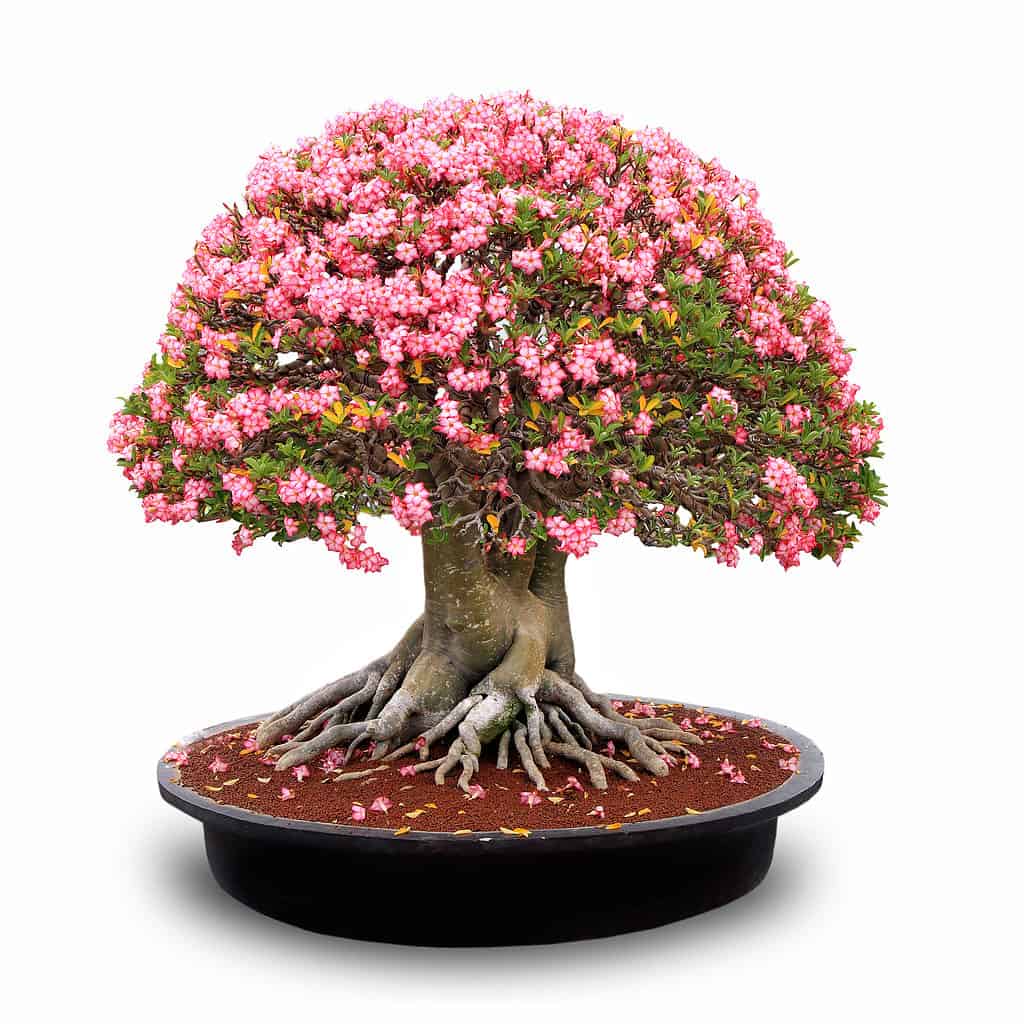
All desert rose Bonsai trees belong to the
Adeniumgenus, with
Adenium obesumbeing the most common species.
©goldenjack/Shutterstock.com
| Desert Rose Bonsai Tree Facts | |
|---|---|
| Botanical Name | Adenium obesum, Adenium arabicum |
| Common Subspecies | Oleifolium, Swazicum, Somalense |
| Sunlight | Full, direct sunlight indoors; partial shade during the heat of the day outdoors |
| Soil | Must be well-draining; Bonsai soil types with rocks and succulent soil mixtures work well |
| Water | Weekly, but check your soil. Must dry out in between waterings, as succulent stems store water |
| For Beginners? | Yes! Enjoys container planting and bounces back easily so long as it isn’t overwatered |
| Indoors or Outdoors? | Both, but likely indoors; very climate-dependent |
| Pairs Well With… | Details around its bulbous trunk base, or trim with care to produce as many flowers as possible! |
Common Types of Desert Rose Bonsai Trees
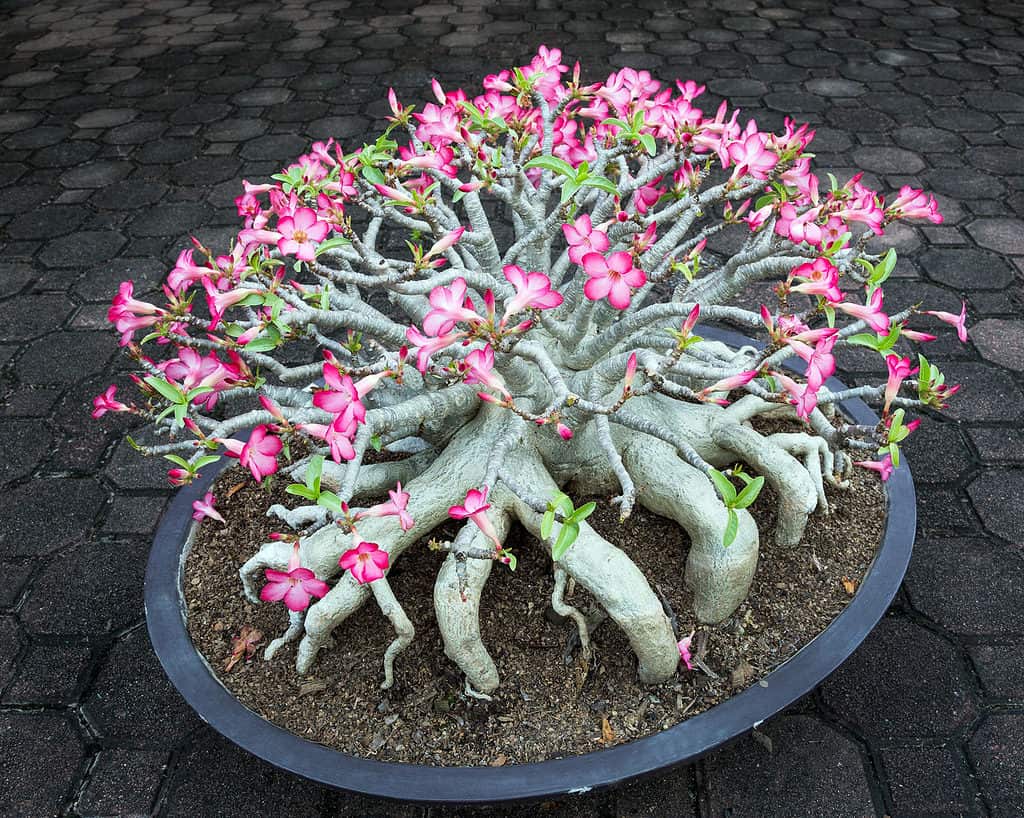
Compared to some fussier tree or plant choices, desert rose Bonsai trees can thrive indoors with enough sunlight.
©jeep2499/Shutterstock.com
All desert rose Bonsai trees belong to the Adenium genus, with Adenium obesum being the most common species. However, there are a number of subspecies of desert rose Bonsai trees that should be mentioned. The care for these different subspecies doesn’t vary, but the appearance and flower production will. Let’s take a closer look.
Oleifolium
Similar in appearance to a baobab tree, the oleifolium subspecies of the desert rose plant grows in miniature. In fact, this plant specimen averages less than 20 inches when fully grown, making it a great choice for a miniatured garden or Bonsai tree container. The flowers it produces are either pink, red, or white.
Swazicum
Also known as the Impala Lily, the swazicum subspecies grows short too. Taller than the oleifolium subspecies, swazicum reaches less than 30 inches tall on average. It’s popular in Bonsai tree production, creating delicate flowers amidst dark green leaves. The flowers are more often pink than any other color.
Arabicum
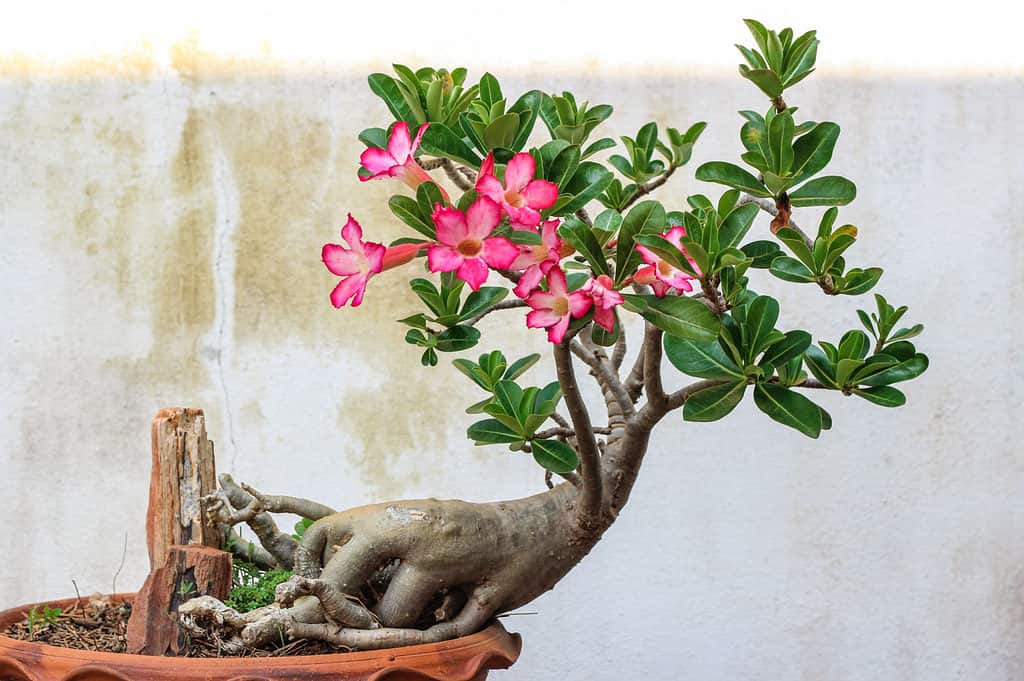
You should plan on potting your desert rose Bonsai tree in a soil mixture, preferably one that incorporates lava rocks, pumice, or other elements that promote drainage.
©NOTE OMG/Shutterstock.com
Another extremely popular species for Bonsai tree production has to be the Adenium arabicum species. This may or may not be a subspecies of Adenium obesum; it hasn’t been determined. However, the leaves on this shrub grow quite larger compared to other Adenium obesum plants. You would think that this doesn’t lend well to Bonsai tree cultivation, but this desert rose cultivar is among the most popular of options!
Somalense
The foliage on the Adenium obesum subsp. somalense is what makes it so popular. While typically growing over 10 feet tall in its natural habitat, this desert rose subspecies produces narrow, variegated foliage. This makes it ideal for Bonsai tree cultivation, especially when paired with delicate, clustered flowers.
Caring for Your Desert Rose Bonsai Tree
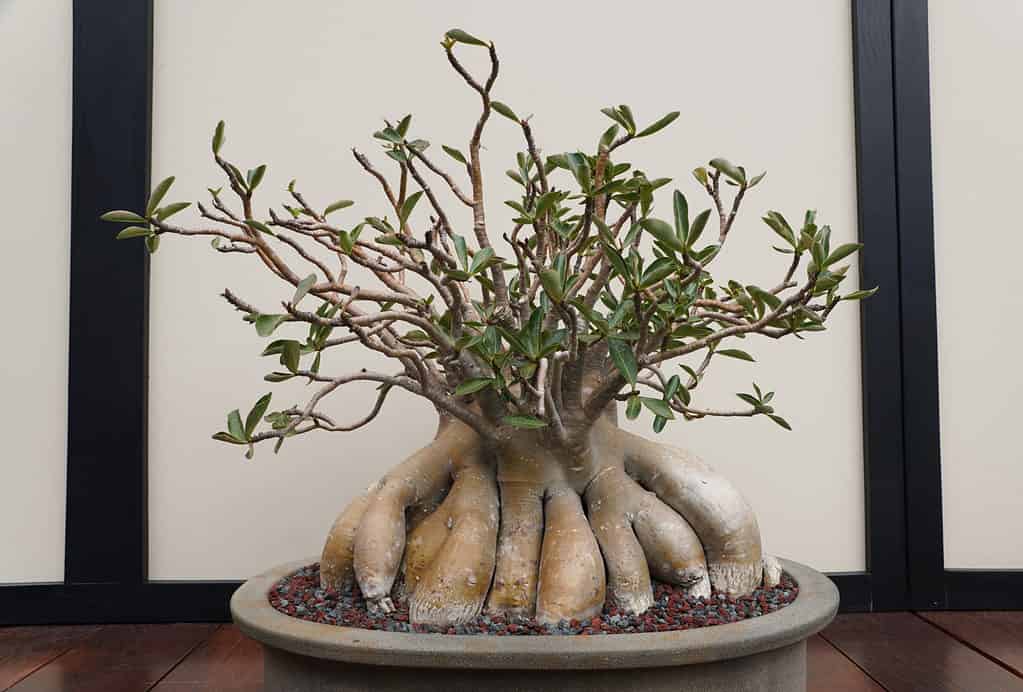
This shrub is highly equipped to store water away for when it needs it most, which means that over-watering can be the death of any desert rose plant.
©Khairil Azhar Junos/Shutterstock.com
While caring for any type of Bonsai tree is a dedicated effort, a desert rose Bonsai tree is among the simplest of options. Compared to some fussier tree or plant choices, desert rose Bonsai trees can thrive indoors with enough sunlight. Plus, keeping a desert rose plant outdoors in the right climate makes its care even easier!
Let’s take a look at all of the care requirements for this Bonsai tree.
Sunlight
Depending on whether you place your desert rose indoors or out, most specimens will thrive in full sunshine. This is especially true for indoor-grown desert rose Bonsai trees. However, when grown outdoors, your desert rose Bonsai tree may benefit from some protection during the hottest parts of the day. A simple covering or location that receives partial shade may be all you need, as these Bonsai trees thrive in full sun!
Soil Type
All Bonsai trees need soil that is well-draining, but a desert rose Bonsai tree needs even more drainage properties overall. This is because of the succulent trunks and stems found with this plant species. It naturally hoards water due to its natural environment, something that’s good news for those of you who forget to water your plants. You should plan on potting your desert rose Bonsai tree in a soil mixture, preferably one that incorporates lava rocks, pumice, or other elements that promote drainage.
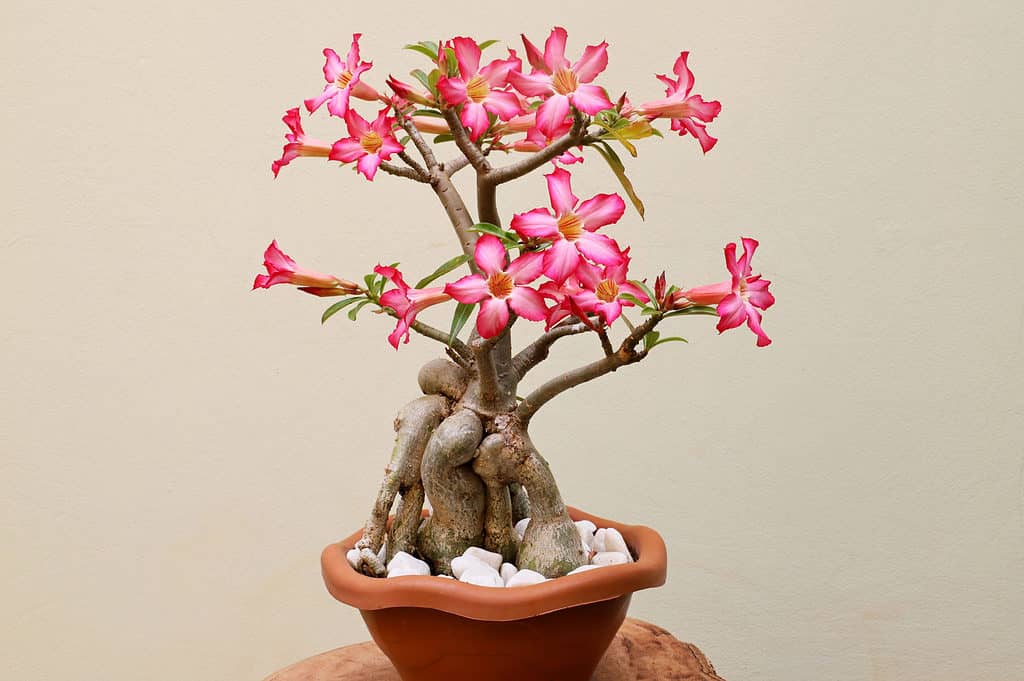
You can always bring your desert rose indoors for the wintertime or provided some protection in a greenhouse, so long as temperatures remain safe for it.
©Mirian Goulart Nogueira/Shutterstock.com
Water
Speaking of water, your desert rose Bonsai tree will need less water compared to other plants or tree species. As its name implies, the desert rose Bonsai tree is native to regions that are particularly arid and dry. This shrub is highly equipped to store water away for when it needs it most, which means that over-watering can be the death of any desert rose plant.
Once the soil of your desert rose Bonsai tree has dried out, you can water it a little at a time. This likely won’t need to happen more than once a week, but it depends on your climate and the temperature conditions that your tree is growing.
Placement
Depending on where you live, your desert rose Bonsai tree may survive outdoors year-round. However, anything below 45 degrees Fahrenheit for an extended amount of time can be difficult for most desert rose species and subspecies, so keep this in mind. You can always bring your desert rose indoors for the wintertime or provided some protection in a greenhouse, so long as temperatures remain safe for it.
If you choose to grow your desert rose Bonsai tree indoors for its lifetime, make sure you place it in a bright, sunny location. Your tree will suffer if it doesn’t receive enough light and warmth, so make sure you prioritize this for your plant. Owning a desert rose Bonsai tree is the most rewarding when it is able to grow flowers, something that it will struggle to do if it isn’t receiving enough light!
Pruning Your Desert Rose Bonsai Tree
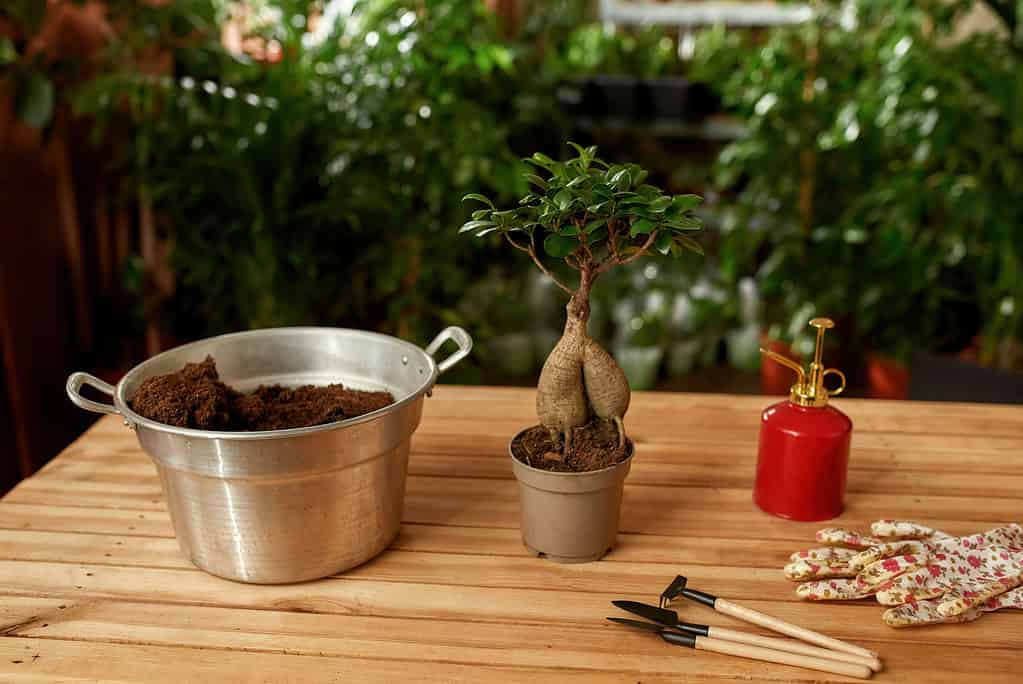
Keep in mind that your desert rose Bonsai tree may not produce its signature, bulbous trunk if you propagate it from a cutting rather than from seed.
©BAZA Production/Shutterstock.com
One of the reasons why a desert rose Bonsai tree is great for beginners is the fact that you can prune it during any time of year or season. However, springtime is the best time to prune a desert rose Bonsai tree if you want more flowers to grow. It is stimulated by pruning, as well as the removal of any dead or leggy components of the plant.
Something to keep in mind is that the sap or seepage that comes from a desert rose plant when you prune it is in fact poisonous. Many experts recommend wearing gloves while you prune your desert rose Bonsai tree, and you should always keep this sap away from children and animals. So long as you prune with care, your desert rose Bonsai tree will appreciate it!
Recommended Desert Rose Bonsai Tree Styles
Your desert rose Bonsai tree should be fairly easy to shape and cultivate. Most Bonsai tree styles work well for this particular plant, but the thick and bulbous trunk makes it ideally grown as a single tree rather than as a forest or in a pot with other specimens. Keep in mind that desert rose plants have fairly succulent limbs and trunks, so shape them with care. Wiring these trees can easily damage them if you aren’t paying attention, so take your time with this one!
Propagating Your Desert Rose Bonsai Tree
If you know a friend with a desert rose plant or tree, you can easily take a cutting from an existing specimen to propagate. Cuttings are best taken during the spring and summertime when growth is at its maximum. However, keep in mind that your desert rose Bonsai tree may not produce its signature, bulbous trunk if you propagate it from a cutting rather than from seed.
Growing desert rose Bonsai trees from seed is a fairly easy task, though it will take longer than if you grew a tree from a cutting. However, this is the best way to ensure that your desert rose plant looks the way you want it to, including its unique trunk and branch structure. All Bonsai tree cultivation takes time, so growing one from seed may not be so bad!
Common Problems with Desert Rose Bonsai Trees
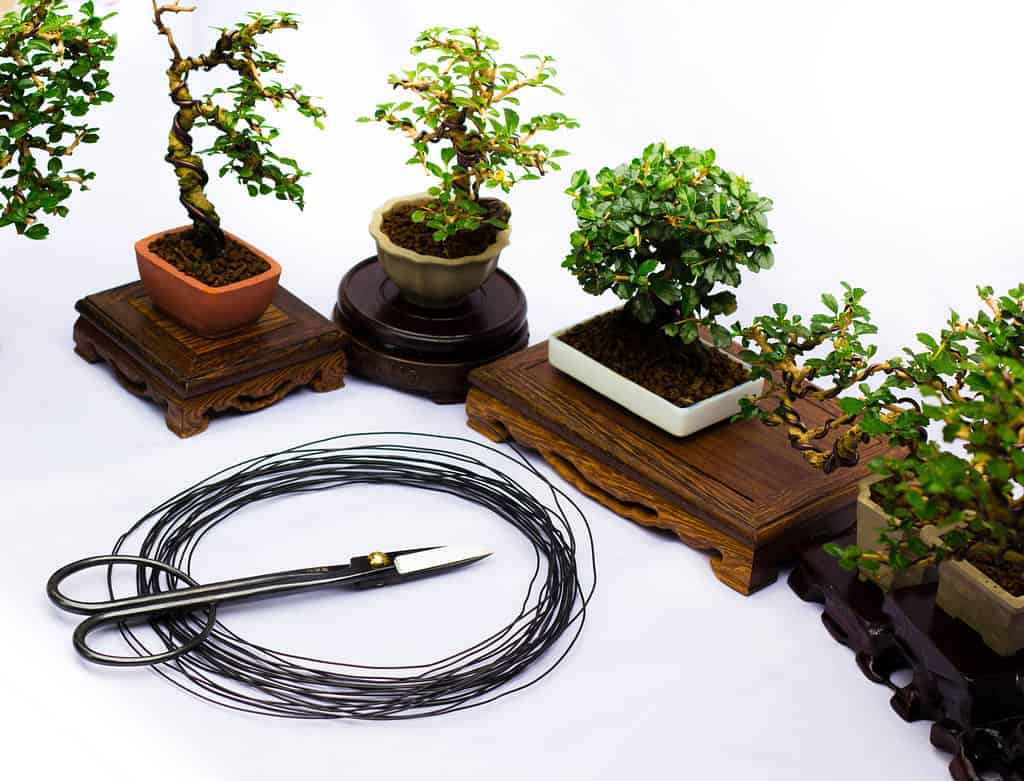
Owning a desert rose Bonsai tree is the most rewarding when it is able to grow flowers, something that it will struggle to do if it isn’t receiving enough light!
©GrooTrai/Shutterstock.com
Depending on where you keep your desert rose Bonsai tree, you may run into a few different common problems. Root rot or overwatering is a key concern for most desert rose plant owners, so pay attention to the overall health and wellness of your plant after the first few watering sessions. You may also damage your desert rose Bonsai tree during wiring or shaping. Make sure to only wire your desert rose plant if you are feeling confident, and never wire them too tightly. They scar easily, especially if wired for too long!
Like other houseplants, desert rose Bonsai trees kept indoors may have trouble with bugs or other pest infestations. They aren’t plagued by anything specific, such as ash Bonsai trees being at risk of attack from ash borers. However, desert rose plants may encounter the following pests:
- Scale
- Spider mites
- Mealybugs
When kept outdoors, aphids may plague your desert rose Bonsai tree. However, keeping your tree healthy and happy is the best way to prevent any and all of these pests from happening! For the most part, your desert rose likely won’t have too many issues. This is especially true if you keep up with its overall care, fertilizing routine, and watering habits.
The photo featured at the top of this post is © NOTE OMG/Shutterstock.com
Thank you for reading! Have some feedback for us? Contact the AZ Animals editorial team.




